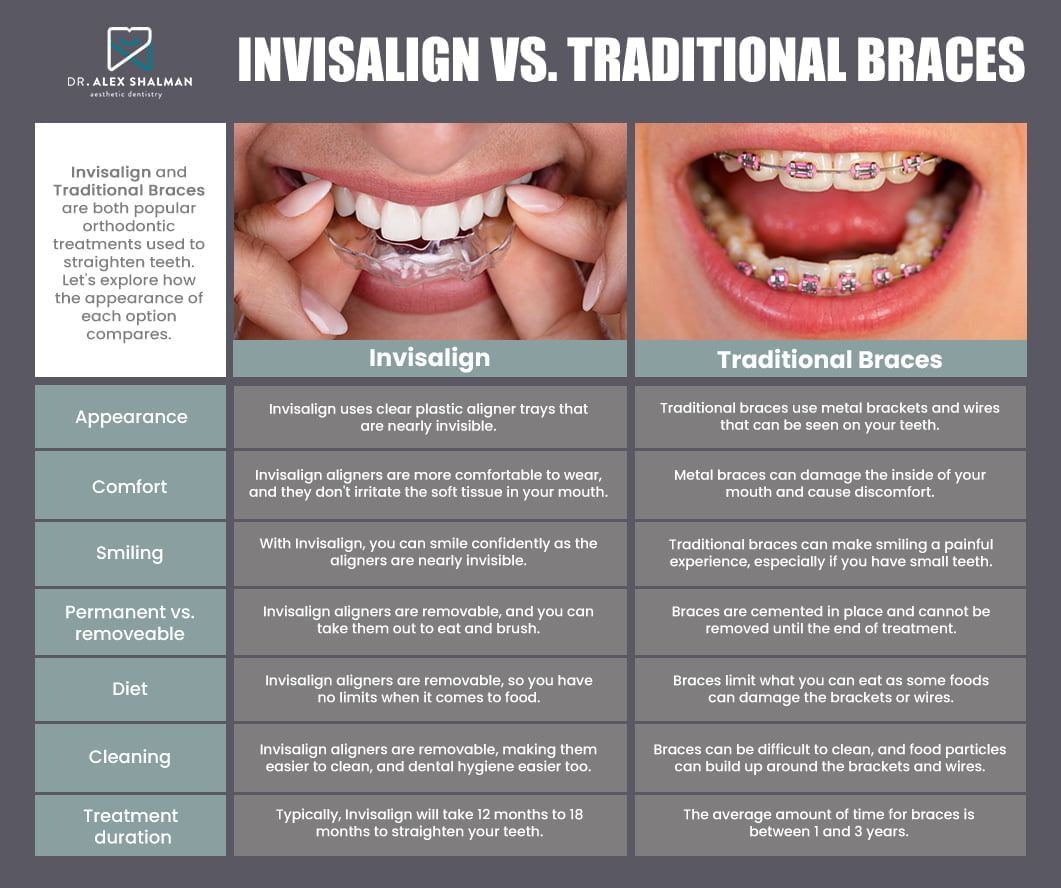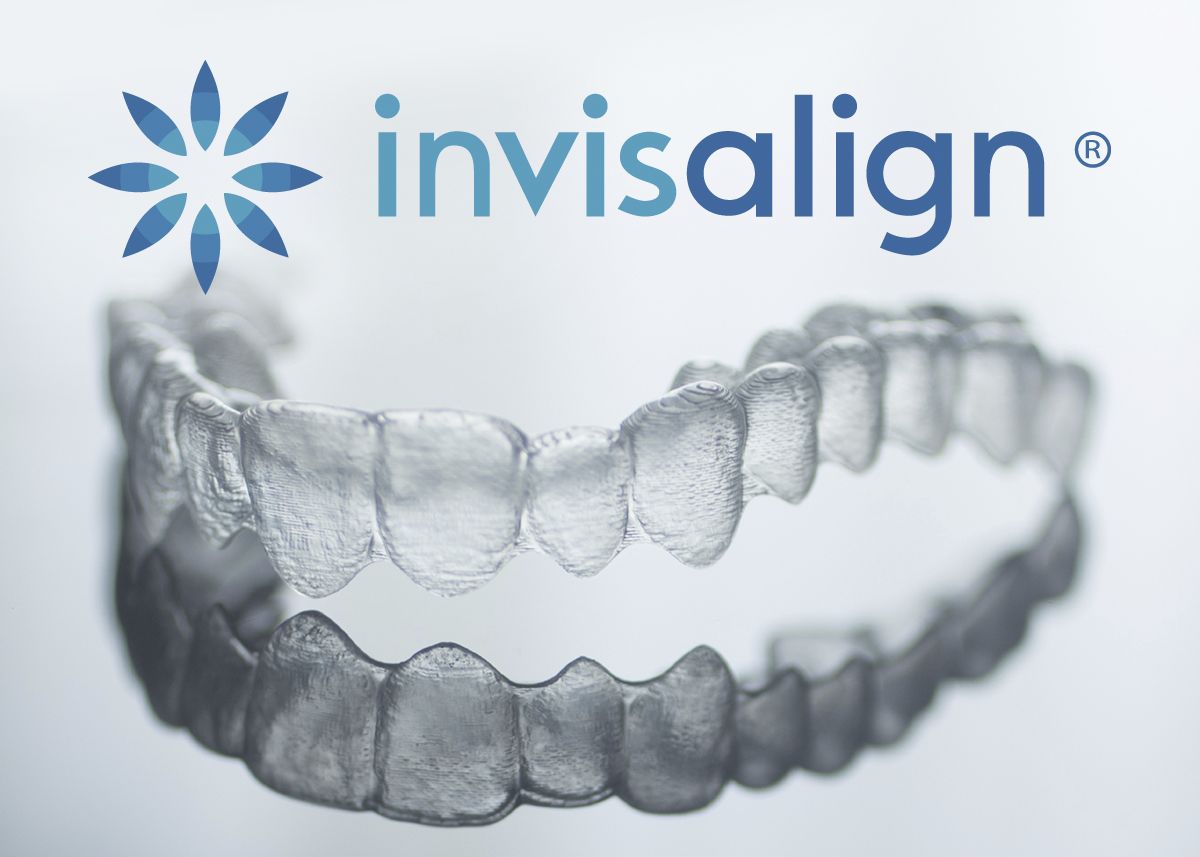The Ultimate Comparison: Invisalign vs. Traditional Braces for Adults
The Ultimate Comparison: Invisalign vs. Traditional Braces for Adults
Blog Article
Invisalign vs. Typical Braces: Which Choice Is Right for You?
When considering orthodontic treatment, the option between Invisalign and standard dental braces presents a number of crucial factors that merit mindful analysis. Invisalign offers a discreet option with detachable aligners, while conventional braces give a much more noticeable yet reliable option for severe imbalance. Each choice encompasses distinct advantages and disadvantages connected to aesthetics, convenience, treatment period, and cost. Comprehending these nuances is critical for making an informed decision that aligns with your personal choices and way of living. The concern stays: which choice will finest meet your orthodontic requirements and assumptions?
Summary of Treatment Alternatives

In comparison, conventional dental braces contain metal brackets and cords that are bonded to the teeth. This method uses continuous pressure with time to achieve placement. While effective for complicated orthodontic concerns, conventional dental braces call for routine sees for changes and can pose difficulties in keeping dental hygiene as a result of the difficulty of cleaning up about brackets and cords.
Both alternatives have their values, and the selection usually depends upon certain oral problems, way of life choices, and patient compliance. Ultimately, getting in touch with an orthodontic specialist is essential for figuring out one of the most ideal therapy plan tailored to individual needs. Understanding the subtleties of each option can considerably influence the overall success of orthodontic therapy.
Aesthetic Considerations
A considerable element influencing the selection between Invisalign and traditional dental braces is the visual appeal each therapy uses. Invisalign aligners are crafted from clear plastic, making them essentially undetectable when used.
In contrast, typical braces consist of steel brackets and wires, which can be extra recognizable. While innovations in orthodontic innovation have brought about the advancement of smaller sized brackets and colored elastics, conventional dental braces still keep an even more noticeable profile. For some individuals, the visibility of dental braces may deter them from looking for necessary therapy.
Eventually, the choice between Invisalign and typical braces might depend upon personal choices concerning looks. Patients that focus on discretion usually favor Invisalign, while those who are much less concerned regarding presence might go with typical dental braces. Comprehending the visual effects of each option is critical for making a notified choice that aligns with one's way of living and choices.
Convenience and Convenience

In terms of convenience, Invisalign Read Full Article aligners are detachable, making it possible for individuals to appreciate their favored foods without constraint and preserve optimal dental health. Brushing and flossing are simplified, as the aligners can be gotten during these regimens, whereas standard braces require mindful navigating around brackets and wires.
In comparison, standard braces require normal adjustments, making them much less convenient for those with hectic timetables. Overall, the convenience and convenience of Invisalign make it an attractive selection for numerous people seeking orthodontic treatment.
Therapy Period and Effectiveness
While both Invisalign and standard dental braces work in dealing with dental misalignments, the period of therapy can vary dramatically between both alternatives. Usually, Invisalign therapy can take anywhere from 12 to 18 months, depending on the complexity of the instance. The clear aligners work by slowly changing teeth into their preferred placements, and routine follow-ups with an orthodontist aid make certain development continues to be on track.
In contrast, standard dental braces frequently need a longer commitment, usually ranging from 18 months to 3 years. This results from their set nature and using brackets and wires, which can be more effective for severe misalignments and complex cases (Invisalign). The therapy performance of conventional braces is well-documented, as they enable specific modifications and better control over tooth activity
Inevitably, the option between Invisalign and typical dental braces might hinge on both the awaited treatment duration and the specific oral issues available. Consulting with an orthodontist is essential, as they can provide customized referrals based upon private needs, guaranteeing the chosen method aligns with preferred outcomes and durations.
Price Contrast and Insurance Policy Alternatives
Expense plays a significant duty in the decision-making procedure for individuals thinking about orthodontic treatment, whether deciding for Invisalign or typical braces. On average, the price of Invisalign ranges from $3,000 to $8,000, while traditional dental braces commonly set you back between $2,000 and $6,000. Variables affecting these costs consist of the complexity of the situation, the period of therapy, and why not try here geographical place.
Many dental insurance policy plans supply partial protection for orthodontic therapies, yet the specifics can differ extensively. Typically, standard dental braces may be a lot more regularly covered by insurance plans contrasted to Invisalign, which some insurance companies categorize as an aesthetic treatment.
In addition, several orthodontic practices use flexible layaway plan, making both treatment choices a lot more accessible. Patients ought to ask about possible funding options and discounts for in advance repayments. Reviewing the total expense, consisting of insurance coverage look at here advantages and payment plans, is important for making an informed decision that straightens with both visual preferences and spending plan considerations.

Conclusion
In summary, the choice between Invisalign and conventional braces hinges on several aspects, consisting of aesthetic preferences, comfort, therapy period, and expense. Invisalign uses a very discreet, detachable choice that promotes dental health and dietary versatility, while conventional braces may be preferable for complex dental issues and often come at a lower cost point. Ultimately, consultation with an orthodontist is vital to examine specific situations and establish one of the most suitable treatment option for attaining ideal dental placement.
When taking into consideration orthodontic treatment, the option between Invisalign and typical dental braces presents numerous crucial elements that warrant cautious assessment.Comparing Invisalign and typical braces discloses unique treatment choices for orthodontic adjustment.While both Invisalign and traditional dental braces are effective in dealing with dental imbalances, the duration of therapy can vary dramatically between the 2 choices.Cost plays a substantial role in the decision-making procedure for people thinking about orthodontic therapy, whether choosing for Invisalign or typical braces.In recap, the selection in between Invisalign and typical braces pivots on numerous elements, consisting of visual preferences, comfort, treatment duration, and expense.
Report this page